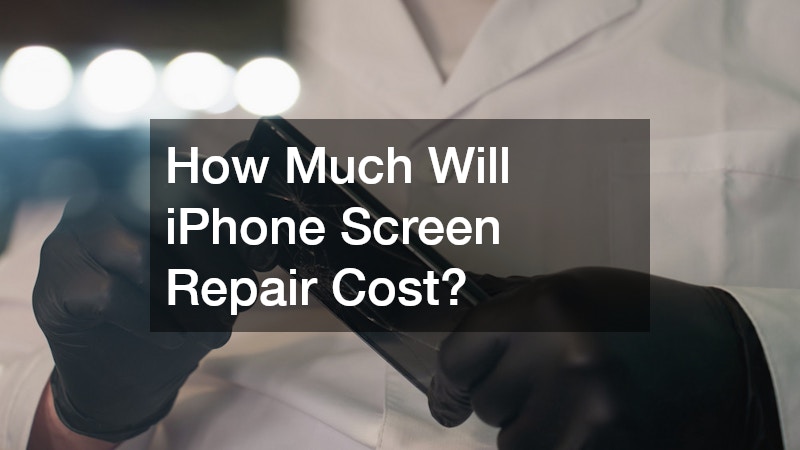An iPhone screen is one of the most vulnerable parts of the device and is prone to damage from drops, falls, or even pressure. Understanding the various iPhone screen repair options available can save you time, money, and the heartache of dealing with a malfunctioning phone.
With the rise in the number of iPhones in use, cracked screens have become a common issue faced by many. Although they can be frustrating, knowing how to deal with them effectively is crucial for maintaining the functionality of your device.
The repair choices range from DIY approaches to seeking professional help, depending on the severity of the damage. Assessing these options allows iPhone users to make informed decisions based on convenience and cost.
What Are the Common Types of iPhone Screen Damage?
Surface Cracks vs. Internal Damage
Surface cracks in iPhone screens can vary from minor scratches to full-blown shattering of the glass. Unlike surface cracks, internal damage can significantly affect the phone’s touchscreen responsiveness and display quality.
Surface-level damages are usually cosmetic, while internal issues might impair the phone’s performance or even render it unusable. Identifying the nature of the damage is the first step in deciding the next course of action.
Understanding these differences is essential to determining if your screen issue is purely aesthetic or if it requires immediate professional intervention. Being informed about the specific type of damage can guide your iPhone screen repair decisions.
How to Identify the Extent of the Damage
Assessing whether the damage is just on the surface or has affected the internal components is crucial. If your screen still displays images clearly and responds to touch, the damage might be confined to the surface.
On the other hand, flickering screens or unresponsive touch inputs can indicate deeper issues. In some cases, despite visible cracks, the display may work fine initially but might degrade over time.
Conducting a thorough check of the screen’s functionality can help you determine the urgency of repair. Being aware of these symptoms allows users to seek timely repairs before further complications arise.
Can I Repair My iPhone Screen Myself?
Pros and Cons of DIY Repair
Embarking on a DIY repair can be cost-effective, as it usually involves purchasing a repair kit. However, the lack of technical expertise may result in further damage to the device.
While the satisfaction of fixing your device yourself can be rewarding, it comes with risks, including voiding any existing warranty. Weighing these pros and cons helps in deciding whether self-repair is a viable option.
For those confident in their technical skills, it presents an opportunity to save money, but it comes with a potential learning curve. Evaluating your comfort level with delicate electronics should guide your decision on DIY repairs.
Essential Tools and Kits for Home Repair
To undertake a successful DIY repair, having the right tools and kits is vital. Most kits available in the market include screwdrivers, adhesive strips, and replacement parts.
High-quality repair kits can enhance your repair experience, ensuring that you have all the necessary components to complete the job. Researching and investing in a reliable kit can be beneficial in case of future repairs.
Alongside the tools, tutorial videos, and guides can provide valuable assistance during the repair process. Being well-prepared with the right resources reduces the risk of unsuccessful repair attempts.
How Do I Choose a Professional Repair Service?
Factors to Consider When Selecting a Repair Provider
Selecting a suitable repair service requires careful consideration of various factors, including cost, expertise, and reputation. Reading reviews and customer feedback can provide insights into the quality of service.
Time is another critical factor, as certain providers offer quicker services than others. Balancing cost-effectiveness with quality and speed ensures that you find the best-fit service for your needs.
Personal recommendations from friends or family who have had similar repairs can also guide your choice. Thorough research helps in making an informed decision regarding professional repair services.
Authorized vs. Unauthorized Repair Centers
Authorized repair centers generally guarantee the use of original manufacturer parts, but their services may come at a higher price. These centers often have trained technicians who specialize in Apple products.
Conversely, unauthorized repair centers may offer more competitive pricing, but with a risk of using third-party or refurbished parts. Discerning between the two types of centers involves assessing your priorities, whether they lie in quality, price, or convenience.
Authorized services can also preserve any existing warranties, adding an extra layer of security to your repair. Weighing the benefits and drawbacks of each option guides customers to choose the most suitable repair service.
How Much Will iPhone Screen Repair Cost?
Price Ranges for Different iPhone Models
Repair costs can vary widely depending on the iPhone model and the extent of the damage. Newer models generally have higher repair costs due to more advanced technology and screen specifications.
Older models might be cheaper to repair, but the availability of parts can affect pricing. In general, the screen repair cost can range from $100 to $400, with variations based on the service provider.
Being aware of these price ranges helps iPhone users budget for potential repairs ahead of time. Understanding that repair costs can vary based on these factors is crucial for planning accordingly.
Insurance and Warranty Considerations
Having insurance or an extended warranty can significantly offset repair costs, especially for expensive repairs. Checking whether your device is still under warranty should be a priority before paying for repairs out of pocket.
Insurance policies often cover accidental damage, including screen repairs, provided certain conditions are met. Familiarizing yourself with the terms and coverage can lead to substantial savings.
Knowing how your insurance or warranty works can provide peace of mind, ensuring that you are not left unprotected against high repair costs. Consider these factors as part of your overall repair strategy.


